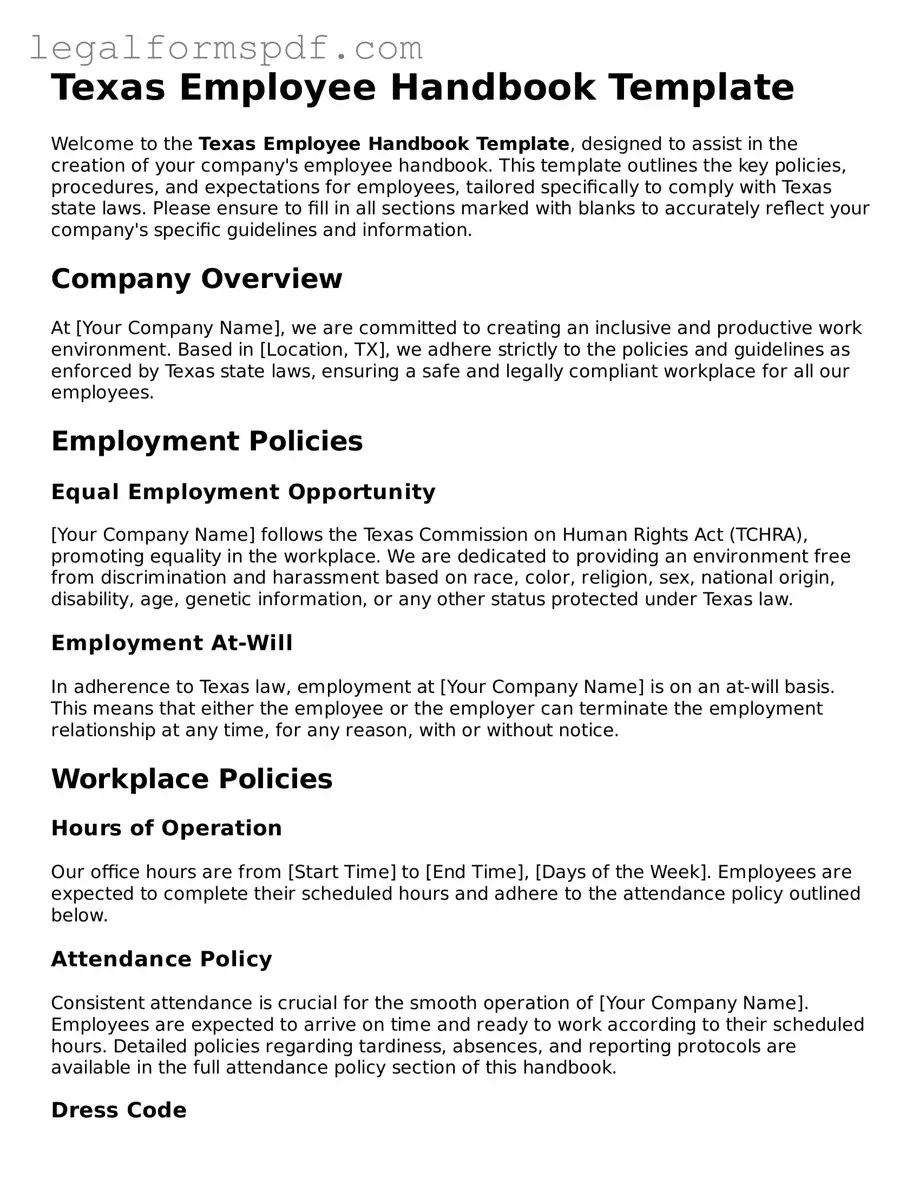Texas Employee Handbook Template
Welcome to the Texas Employee Handbook Template, designed to assist in the creation of your company's employee handbook. This template outlines the key policies, procedures, and expectations for employees, tailored specifically to comply with Texas state laws. Please ensure to fill in all sections marked with blanks to accurately reflect your company's specific guidelines and information.
Company Overview
At [Your Company Name], we are committed to creating an inclusive and productive work environment. Based in [Location, TX], we adhere strictly to the policies and guidelines as enforced by Texas state laws, ensuring a safe and legally compliant workplace for all our employees.
Employment Policies
Equal Employment Opportunity
[Your Company Name] follows the Texas Commission on Human Rights Act (TCHRA), promoting equality in the workplace. We are dedicated to providing an environment free from discrimination and harassment based on race, color, religion, sex, national origin, disability, age, genetic information, or any other status protected under Texas law.
Employment At-Will
In adherence to Texas law, employment at [Your Company Name] is on an at-will basis. This means that either the employee or the employer can terminate the employment relationship at any time, for any reason, with or without notice.
Workplace Policies
Hours of Operation
Our office hours are from [Start Time] to [End Time], [Days of the Week]. Employees are expected to complete their scheduled hours and adhere to the attendance policy outlined below.
Attendance Policy
Consistent attendance is crucial for the smooth operation of [Your Company Name]. Employees are expected to arrive on time and ready to work according to their scheduled hours. Detailed policies regarding tardiness, absences, and reporting protocols are available in the full attendance policy section of this handbook.
Dress Code
Our company dress code varies by department but aims to balance professionalism with comfort. Please refer to the department-specific guidelines or consult with your supervisor to understand the expectations for your role.
Benefits and Compensation
Salary and Wages
[Your Company Name] ensures competitive and fair compensation for all employees, compliant with the Texas Minimum Wage Act. Salaries are determined based on the role, experience, and performance of the individual.
Benefits Overview
Eligible employees at [Your Company Name] receive a comprehensive benefits package, which may include health insurance, dental and vision plans, retirement savings plans, paid time off, and more. Detailed information regarding eligibility, enrollment, and plan specifics are available in the benefits summary section.
Leave Policies
Paid Time Off (PTO)
Employees are encouraged to use their PTO for rest, relaxation, or personal matters. PTO accrual rates, usage guidelines, and approval procedures are outlined in the PTO policy section.
Family and Medical Leave
In accordance with the Texas Family Leave Act (TFLA), eligible employees are entitled to take unpaid, job-protected leave for verified family and medical reasons. Detailed information about eligibility, duration, and how to apply for TFLA leave is documented in the family and medical leave section.
Conduct and Performance
Code of Conduct
All employees are expected to conduct themselves in a manner that reflects positively on [Your Company Name] and complies with all policies outlined in this handbook. Violations of the conduct code may result in disciplinary action.
Performance Review Process
Regular performance reviews help in assessing employee contributions, setting goals, and identifying areas for development. [Your Company Name] conducts performance reviews on a [frequency] basis.
Acknowledgement
This handbook is designed to provide a comprehensive overview of [Your Company Name]'s policies and procedures. Employees are required to acknowledge that they have received, understood, and agreed to adhere to the guidelines contained within this handbook.
